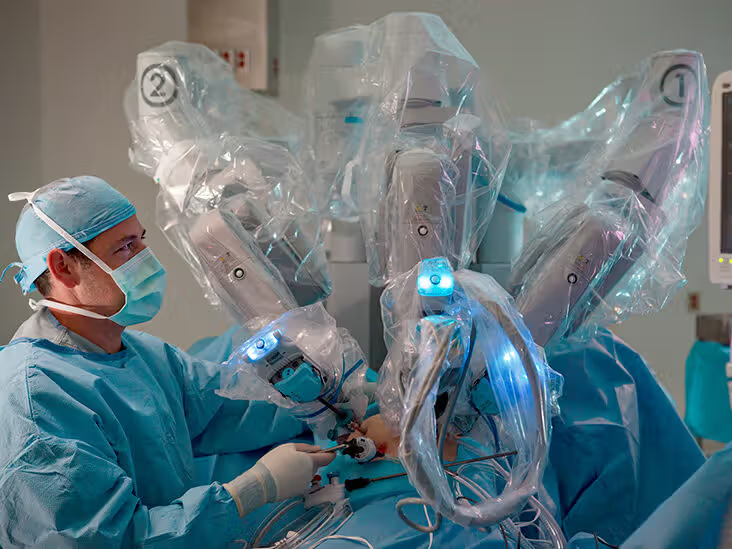Robotic Hysterectomy is a technology that eases the process of hysterectomy among patients. Hysterectomy is a surgical procedure that involves the removal of the uterus; this was done back in the day through open or laparoscopic means. These techniques worked but had certain disadvantages like prolonged healing periods, bigger incisions and increased chances of developing complications. In contrast, robotic hysterectomy, a kind of keyhole surgery that is performed with the aid of robotic arms, is a better alternative because of the shorter recovery times, increased accuracy and improved patient outcomes. Let’s take a detailed look at the advantages of this procedure for a better understanding.
Understanding the Robotic Hysterectomy
Robotic hysterectomy is considered a type of laparoscopic hysterectomy where the uterus is removed with the help of a robotic-assisted system. The device which is most widely employed for this is the Da Vinci Surgical System, which is a system that allows one to see the operated area in a high-quality 3D. The system incorporates crystalline optics, which provide sharp, three-dimensional images of the surgical field, and sophisticated mimicry systems that enhance manual dexterity while performing delicate surgical operations.
Applications of Robotic Hysterectomy
Robotic hysterectomy is indicated for various gynaecological conditions, including:
- Uterine fibroids: Non-cancerous growths in the uterus that can cause heavy menstrual bleeding, pelvic pain, and pressure symptoms.
- Endometriosis: A condition where the tissue that normally lines the inside of the uterus grows outside the uterus, causing pain and infertility.
- Uterine Prolapse: A condition where the uterus descends into or out of the vaginal canal due to weakened pelvic muscles.
- Chronic Pelvic Pain: Persistent pain in the lower abdomen that can be associated with various gynecological issues.
- Gynecologic Cancers: In cases where cancer affects the uterus, ovaries, or cervix, a hysterectomy may be required as part of the treatment plan.
- Abnormal Uterine Bleeding: Severe or prolonged menstrual bleeding that does not respond to other treatments.
How Robotic Hysterectomy is Performed?
During a robotic hysterectomy, the patient is placed under general anaesthesia. The surgeon makes several small incisions in the abdomen, through which the robotic arms and a camera are inserted. The surgeon then operates from a console, using controls to manipulate the robotic arms holding surgical instruments. The enhanced visualisation and precision provided by the robotic system allow for meticulous dissection and removal of the uterus, with minimal damage to surrounding tissues.
Depending on the patient’s condition, the surgeon may also remove the ovaries, fallopian tubes, and other structures during the procedure. The uterus is typically removed through the vagina (vaginal hysterectomy) or through one of the small incisions (laparoscopic hysterectomy).
Advantages of Robotic Hysterectomy
Robotic hysterectomy offers several advantages over traditional open or laparoscopic hysterectomy, making it a preferred choice for many surgeons and patients. These advantages include:
1. Minimally Invasive Approach:
One of the most significant benefits of robotic hysterectomy is that it is minimally invasive. The procedure involves small incisions, typically less than 1 cm in size, compared to the large incision required for an open hysterectomy. Smaller incisions lead to less postoperative pain, reduced scarring, and a lower risk of infection.
2. Enhanced Precision and Control:
The robotic system provides the surgeon with a high-definition, 3D view of the surgical site, magnifying the area up to ten times. This enhanced visualisation, combined with the dexterity of the robotic arms, allows the surgeon to perform the surgery with greater precision and control. The robotic instruments can move in ways that human hands cannot, enabling the surgeon to navigate around delicate structures and reduce the risk of damaging surrounding tissues.
3. Reduced Blood Loss:
Robotic hysterectomy is associated with less blood loss during surgery compared to traditional methods. The precision of the robotic system allows for more controlled and accurate cutting, which minimises trauma to blood vessels. This is particularly important for patients with conditions such as anaemia or those who are at higher risk of bleeding.
4. Shorter Hospital Stay and Faster Recovery:
Patients who undergo this procedure typically experience a shorter hospital stay and faster recovery compared to those who have an open hysterectomy. Most patients are discharged within 24 hours of the procedure, and they can return to normal activities within 2 to 3 weeks. In contrast, recovery from an open hysterectomy can take up to 6 to 8 weeks.
5. Lower Risk of Complications:
The minimally invasive nature of robotic hysterectomy, combined with the enhanced precision of the procedure, results in a lower risk of complications such as infections, hernias, and adhesions. The smaller incisions also reduce the likelihood of wound-related issues, which are more familiar with open surgeries.
6. Improved Cosmetic Outcomes:
With this procedure, the small incisions result in minimal scarring, aesthetically preferable for many patients. The scars are usually small and fade over time, leading to better cosmetic outcomes than the larger scar left by an open hysterectomy.
7. Versatility in Treating Complex Cases:
Robotic hysterectomy is particularly beneficial for treating complex cases involving severe endometriosis, large fibroids, or adhesions from previous surgeries. The enhanced dexterity and precision of the robotic system make it easier to perform intricate dissections and maneuvers that would be challenging with traditional laparoscopic or open techniques.
Conclusion
Robotic hysterectomy represents a significant advancement in gynaecological surgery, offering numerous benefits over traditional hysterectomy methods. Its minimally invasive nature, enhanced precision, and quicker recovery make it an ideal choice for many women requiring a hysterectomy.
Hospitals like Nanavati Max Super Specialty Hospital in Mumbai are a premier choice for robotic hysterectomy patients. With its expert surgical team, advanced technology, and comprehensive patient care, Nanavati Max ensures that patients receive the best possible treatment for their condition, leading to improved outcomes and a better quality of life.







